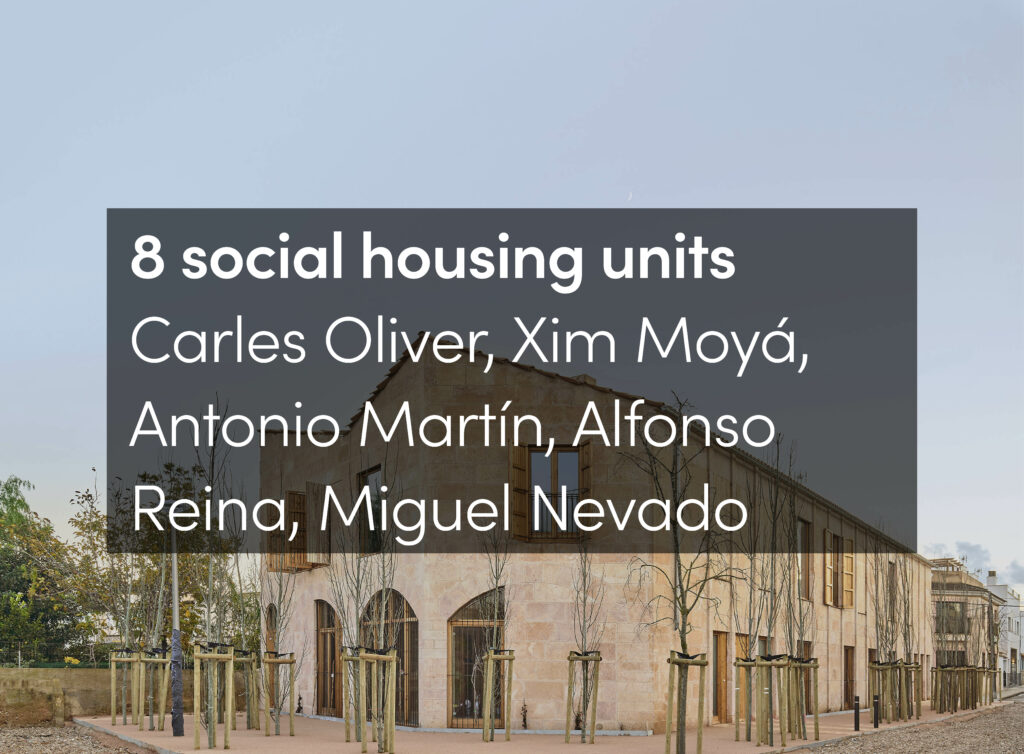The history of public events has been written eliminating women’s contributions. The same has been the case for the history of the construction of cities.
History is written by power, and power is patriarchal. When a values scale is built around an experience, everything that falls outside that perspective remains unknown, rejected and forgotten. Therefore, if the values and experiences of men, through the patriarchal system, are what determine what is good and relatable, then half of humanity is not taken into account. There is no room for other values or experiences or knowledge. This biased assessment is applicable to the stories of all ‘others’ or subalternates: that is to say, ethnic or other minorities, non-whites, non-rich, etc.
Thinking from a perspective other than that of established power carries with it a number of difficulties. The first question is: How can we build a new discourse, with different values, if we have been shaped by the single standard of patriarchal, masculine and sexist values? This situation suggests the difficulty of thinking from outside culture and the symbolic order (Rivera Garreta, 2003) and of finding new indications that let us construct new narratives.
Writing about women and cities also implies describing contributions made from the wrong place, if we subscribe to the organization of gender roles: as a social construction, gender roles constitute a dual and artificial division according to which women are assigned to one space, the interior, and, one working world, reproduction. The invisibility of the private sphere and the lack of recognition of the value of reproduction – which includes all the activities of caring for other members of the family, the home, nutrition, life – have determined, and still determine, the activities carried out by the female gender, since these tasks are still today largely the responsibility and obligation of women. Evidently, these reproductive responsibilities come in addition to productive activities, in which women participate just as much as men. This role, which has historically been difficult to avoid for women, has had its consequences. On the one hand, it has meant that women’s activities in the spheres of production go unseen, since these spheres do not pertain to us, or are not appropriate for us. On the other hand, the invisibility and the lack of value associated with domestic tasks or reproduction has undermined the contributions that women can make from the obligatory and undervalued role they have been assigned.
The city, its construction and its spaces, as the maximum representation of the public sphere, has been a space from which women have been barred – or that is what the dominant narrative of history has led us to believe.
However, women have been and are present in the public action of the construction of the city. In highlighting that role I will refer to two situations that took place at nearly the same time: one, in the Middle Ages, when groups of women gathered to live together; and, the other, at the beginning of the Renaissance, when one woman created a city with her pen. Both cases invoked alternatives to the city models in existence at the time.
The first situation involves groups of women in northern Europe who, beginning in the 13th century, began self-organizing to form independent societies. They built their own spaces and offered women an alternative way of life to the only other options available to them: marriage or the convent.
These Beguine communities, as they were called, were founded by rich widows or heiresses who established independent urban systems that were self-regulated and self-supported. By 1566 there were nearly 300 of them (Simons, 2001). The fact that these enclosures contained religious buildings led them to be classified as convents, when in fact they existed as independent civil societies, which advocated for another form of womanhood: not mothers, or wives, or nuns or brides of Christ, but hardworking and studious individuals. Among their subjects of study were the sacred texts, taking back a part of power from the church and from men who, as parish priests, were the only ones authorized to read and transmit that knowledge based on their own interpretations. In that sense, interpretation as an instrument of power was questioned by these women who defended their own ability to read, interpret and organize themselves in an alternative way. Among other things, the interpretation of Beguine communities as convents is upended by the fact that, if these women had wanted to live in convents, nothing would have prevented them from it: they could either have joined a convent or founded one. Day-to-day organization in Beguine communities was based on the premise that caretaking tasks were undertaken in a shared and professionalized manner – both when it came to the work done for the Beguines themselves and for outsiders who came to live under their care. Community members also traveled outside for work, such as taking care of elderly or sick people, or manufacturing tasks – particularly weaving and embroidery.
The Beguine communities consisted of several buildings organized into streets and squares, and surrounded by walls or moats, creating spaces that were open to the community which housed a variety of services: from educational facilities for young women to charity centers for the poor, the elderly and the sick.
The second example of women in the construction of the city took place during the Renaissance, at a time when literary constructions defined woman – in ballads with supposed philosophical, religious and scientific airs – as a supremely devastating object-being. Rising up against these misogynistic excesses came the “written” voice of one woman, Christine de Pizan (Venice, 1364 – Poissy, 1430). In her most well-known work, The Book of the City of Ladies (de Pizan, 1405-1998), she writes in the first person about the experience of being a woman; her text constituted a change of historical perspective. In the first chapter she lays out the reason why her book was necessary. She wonders what reasons could have led men to invent the figure of women with such disdain. She explains that, despite the different satirical, philosophical or poetic positions of the authors, they all come the same conclusion: women’s behavior is deviant and full of vice. She is incredulous that so many important men could have made such a mistake, calling their own experiences and knowledge into doubt. In writing the book, she seeks out the voices and perspectives of exemplary women – both real and mythical – together with whom, through a conversation, she undertakes the symbolic construction of a city. The construction is founded on the virtues of women’s reason, good behavior and justice to counter the attacks to which women are subjected from literature and pulpits.
Through the City of Ladies, she seeks to break with the public silence imposed on women by an education that promotes a female gender model of submission and privation. Her city of ladies is intended as a space of freedom for women, a city that sets aside destruction and war.
In both these experiences we find at least two fundamental characteristics of female thought and action regarding the city. The first has to do with questioning what is given as certain and absolute, using one’s own experience, so that a transformation of knowledge can take place. The second has to do with proposing societies that are based on collaboration as opposed to competition.
Centuries Later
In the modern period, we have the figure of Flora Tristan (1803-1844) a pioneer in denouncing the situation in which the working classes lived in Victorian London, in an effort to make the invisible visible. Among her books is My Walks Around London, from 1840, which issues a fierce criticism of the situation of people in the English working classes, describing scenes of daily life with details. Her work came ahead of the critical pieces by Marx and Engels, particularly The Condition of the Working Class in England by Engels, from 1845. Flora Tristan’s perspective is a testament to women’s concern for others and for the most forgotten parts of cities.
In this vein, in the second half of the 19th century and the beginning of the 20th, groups of women in England and the United States came together to work toward improving the forgotten areas of cities. In general, reformist women (Ravertz, 1989) approached the problem of housing and the city in an integrated and global way: based on an understanding of the everyday difficulties, specific needs and capabilities of the communities they were working to serve, they proposed progressive and realistic improvements that were rooted in a knowledge of the situation and drew on personal relationships.
Among the first women who opened up new ways of understanding the city and the options for intervention therein was Octavia Hill (1838-1912). She was opposed to the destruction of inhabited buildings and advocated for a progressive improvement of conditions in keeping with the possibilities of the residents. This approach was a precursor for the rehabilitation of neighborhoods and slums. The system that she proposed, and which she put into practice with a group of other women, consisted in improving the living conditions in rental properties where working families were just scraping by. Once the women gained ownership of a building (they acquired their first property in 1864), they carried out an inspection, which included structural aspects as well as existing social relations and the uses of the different spaces. If it was technically possible, the families were presented with a proposal for the progressive improvement of the constructive and hygienic conditions, which could include enlargements, in exchange for the commitment to pay rent, according to each family’s possibilities. The first technical visits also aimed to establish a relationship of familiarity and trust between the people who lived in the buildings and the new management group. This relationship was maintained over time, since the rent was collected weekly in person. These visits served to develop the relationship, to understand problems first-hand and to transmit knowledge on issues of hygiene, health, education and nutrition to the women who were the main agents in these transformations. The money earned from rent was invested in improving the conditions of the surrounding areas, with spaces for children’s playgrounds, in education or in new housing improvement projects.
Red Cross Garden & housing by Ocatvia Hill © Zaida Muxí
By 1874, Hill had taken over 15 residential buildings with 3,000 tenants (Morrell, 1996). As a result of this experience, in 1884 she was offered the management of a large stock of ecclesiastical properties. She accepted on the condition of being able to make considerable improvements, and that the voices of the tenants would be heard. The fact of working with properties that belonged to other owners led to the incorporation of housing blocks under her management, although she was a great critic of this typology. She only accepted them if they were already built and if they were located in an urban area. Her argument in opposing housing blocks was based on the following main criteria: their construction and, certainly, their maintenance, were no more economical than more vernacular houses; the common areas were prone to be a focus of problems, especially related to behavior, order and cleanliness, due largely to the great density of inhabitants; the buildings were generally ugly and without any visual interest; they did not permit the individualization of the family home, and there was no possibility for enlargements or additions, thus limiting the possibilities for people to develop a sense of belonging (Darley, 1990).
She built new homes for working families with the goal of demonstrating that it could be done in a different way: with the aesthetic and architectural conditions and the services associated with the image of garden cities, i.e., small, medium-density constructions, equipped with green spaces and shared facilities. She believed that workers’ housing needed to leave behind the alienating spaces of monotonous and repetitive row houses or the equally impersonal apartment blocks that were usually built for such families. She understood the value of the quality of space in the formation of social groups and the importance of a fondness for and attachment to one’s home.
Red Cross Garden & housing by Ocatvia Hill © Zaida Muxí
One of her most well-known projects is the Red Cross Garden from 1887, in which six model homes and a community room, then known as Red Cross Hall, were built adjacent to the garden. The design was drafted by Elijah Hoole, who was also responsible for Toynbee Hall in 1884 and the Bermondsey Settlement in 1890. The community room provided a library, spaces for the working men’s club, for women’s groups, concerts and plays, poetry readings and calisthenics.
The work directed by Octavia Hill was not limited to housing; she also advocated for introducing children’s playgrounds into cities. She was a great opponent of the suburbs and the destruction of the landscape. She believed that cities should be surrounded by nature, within short distances, to serve as spaces for recreation and social relations. She favored providing the working classes with access to the beauty of natural spaces. She was a member of the Kyrle Society, which defended the preservation of natural enclaves and participated in the defense of common heritage, laying the groundwork for the National Trust. She advocated for acting locally and was critical of the large-scale interventions undertaken by the administration. Her method of working, organizing and managing served as the basis for the British government’s policy between the two world wars.
This attentive approach to reality, attuned to the needs of different groups and their particular abilities, was also characteristic of other groups of women that came together in the late 19th and early 20th century in large cities on the east coast of the United States.
These reformist women were very critical of the actions of municipal governments and coincided in asserting that poverty was not a personal problem but a systemic problem. The work of the Municipal Housekeeping groups centered on the idea that domestic living conditions should be complemented by a suitable urban environment. When the former are poor, it is essential for the public sphere to provide better conditions from within the city. Assuming that if their family responsibility was to maintain their homes, they could translate this responsibility to the public space of the city, “We are in charge of cleaning our houses and ensuring that our houses are comfortable and welcoming and that sick people are taken care of and that everyone is at ease. We are going to do the same with the city” (Spain, 2001).
Chicago was one of the cities where two of the pioneering movements in improving city life came together: the Settlement Movement (Davis, 1991) and the Municipal Housekeeping group (Spain, 2001). At the end of the 19th century, Chicago, like London, was a model city, where, in a short span of time two important urban improvement projects took place: the World’s Columbian Exposition of 1893, with the creation of an urban park on the shores of Lake Michigan; and the Chicago Plan of 1909 by Daniel Burham and Edward Bennett. Chicago tackled large-scale works with the ambition of creating a city like Paris on the American prairie, a city with wide boulevards and monumental perspectives, strategically placed and interconnected parks and avant-garde buildings. However, they failed to take into account, in line with Flora Tristan’s complaint, the lives of people with more limited resources.
The city beyond those public spaces and emblematic buildings was dirty and derelict. These movements considered it unacceptable for water and filth to accumulate in the streets, where the poorest children played and spent their time, abandoned to such an extent that dead animals might be left lying around for days. According to Daphne Spain, the garbage-strewn streets and the noise were considered minor issues compared to the most important threat: poor air quality and water pollution, which were the main problems in cities. The Municipal Housekeeping associations encouraged the construction of public baths for family hygiene, since running water and bathrooms were a luxury only a few families could enjoy. A clean and healthy city had to begin by providing for the cleanliness of its inhabitants.
The improvement of everyday public spaces was managed according to the proposals of these women’s organizations. They directed street cleaning, and they organized nurseries so that children would not be out in the streets while their parents worked, and to guarantee they would eat at least one meal a day.
In the absence of open spaces in the industrial city, the women of the Municipal Housekeeping groups proposed the temporary use of vacant lots to transform them into small children’s playgrounds. The proposal resulted from the observation of a lack of quality public spaces in poor neighborhoods and the existence of abandoned, garbage-filled lots that aggravated unhealthy conditions.
Based on these experiences, associations were formed to create children’s play spaces, where the aim was not necessarily beauty but a clean and adequate space for recreation near their homes. The precursor of the playground movement was founded in Boston in 1880 by Dr. Marie Zarkzewska, where the first “sand gardens” were created – play spaces that fell under the supervision of a local respectable woman. In 1906 the American Playground Association was formed, which coexisted with the City Beautiful movement. The latter advocated for the creation of large green spaces that were beautifully designed and decorated with monuments; they feared that the playgrounds would take away from their budgets. However, large spaces were very expensive and were not useful as everyday recreational areas, which was what interested the Playground Association. This struggle exemplifies two opposing views on the city: living versus exhibiting, residents versus agents. These temporary uses as spaces for children’s play, introduced a tradition that has reappeared today and was reinterpreted during the food crisis of the Great Depression in cities like New York to create gardens, or in Amsterdam by Jakoba Mulder after the Second World War.
Jakoba (Ko) Helena Mulder (1900-1988), an engineer who graduated from the Technische Hogeschool in 1926, began working in the Urban Planning Department in the city of Amsterdam in 1930. That same year, she designed the project that brought her fame among the city’s residents: the Boschplan, now called the Amsterdam Woods (Amsterdamse Bos). This project was both a forerunner in environmental terms and a strategy to improve the city while generating employment during a period of economic depression.
Amsterdam squares – planned by Jakoba Mulder, designed by Aldo van Eyck © MuB
Amsterdam squares – planned by Jakoba Mulder, designed by Aldo van Eyck © MuB
In 1958 Jakoba Mulder succeeded Cornelis van Eesteren as Amsterdam’s director of planning, having previously been the assistant director. In the interwar period, their team drafted the most famous Dutch urban plan: the expansion of Amsterdam. Its importance is reflected in the scale of the plan, which helped the city grow from 750,000 inhabitants in 1930 to nearly one million by the end of the century. The plan laid the foundations for the growth of the so-called garden towns (tuinsteden) like Slotermeer. According to Stephen Ward (Ward, 2002), this plan represents an extremely interesting trend in the professional evolution of planning, since it was the first plan to be deliberately prepared and presented as a team effort. The research by Theo van Lohuizen and the planning work by Jakoba Mulder were both extremely important to the plan.
From the beginning of her career, Mulder was concerned with the lack of adequate places for children to play in the city. She wondered what the reasons for this shortage could be, given how easy these spaces were to provide. Her attention to reality, and to details that were small in scale but had a great impact on people’s quality of life, led her to propose in 1947 a bottom-up system for the creation of public spaces for children’s playgrounds. From her window one day Jakoba Helena Mulder had seen a young girl playing in the street, with no other resources than her imagination, dirt and a tin can, and it occurred to her that it was possible to create small, low-cost spaces that were full of possibilities for children to play. The young Aldo van Eyck volunteered to provide the designs. The mechanism Mulder proposed for creating these spaces always relied on one person or a group of residents who were familiar with the specific needs of the population and could identify and propose vacant lots, corners, sidewalks or other underutilized small urban plots to be transformed into one of these playgrounds. Once the viability had been proven, the city council responded with a specific design. Using this system 700 playgrounds were created between 1948 and 1978, scattered throughout the city of Amsterdam, which Aldo van Eyck had the opportunity to design as an employee of the city’s public works office. A series of simple elements were used to create different playgrounds tailored to each different surface. Each of the playgrounds was unique and, more importantly, incorporated a wide variety of shapes, textures and possibilities, inviting children to use the elements in creative ways (Montaner and Muxí, 2011).
Each of these experiments contains common characteristics that we still see today in contemporary proposals coming from feminisms and perspectives rooted in gender. They show, fundamentally, that our actions should be based on a detailed and close knowledge of reality, which invites approaches that are more suited to each micro reality, leaving behind a universal neutral that masks the hierarchical, masculine experience of patriarchy. And, on the other hand, they show the benefits of collaboration and cooperation between very diverse agents in structures that tend more toward horizontality than a hierarchical pyramid.















